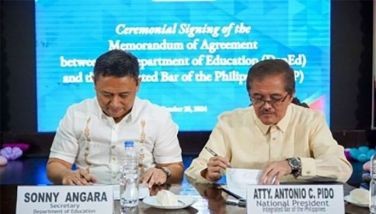“Filipino” identity and Spanish citizenship
A common query from prospective clients is assistance in retrieving documents to prove Spanish ancestry so they may apply for Spanish citizenship through the Ley de Memoria Democrática. The interest in getting Spanish citizenship has become even more popular now because the Spanish government has once more extended the deadline from October 21 this year to the end of next year.
The Ley de Memoria Democrática or the Ley de Nietos was meant to “address and rectify the injustices experienced by victims of the Franco regime and directed towards the descendants of exiles and those who suffered persecution during the dictatorship to apply for Spanish citizenship”, an effort to heal historical wounds and reconnect with its diaspora. Over the last few years, Spain has expanded the law to include citizens of their former colonies who can prove Spanish descent. Anyone applying should be able to prove a connection to a grandparent (extended to a great-grandparent) who was born in Spain.
Speaking of Spanish citizenship, today, September 4, in 1832, Marcelo de Azcárraga y Palmero was born in Binondo, Manila. He would later become prime minister of Spain, serving in 1897, 1900–1901, and then 1904–1905. Filipinos love to claim anyone famous from other countries as one of “our” own when we discover they have Filipino blood in their veins. Think of British gymnast Jake Jarman and at least six other athletes in the recent Paris Olympics who were celebrated by our people as “Filipinos” as well. So if we love to claim foreigners with Filipino ancestry as our own, then former Spanish prime minister Azcarraga tops that list.
Strictly speaking, Azcarraga’s claim to being Filipino was maternal as his father was a Spaniard born in Spain. His mother, Doña María de la Concepción Isidra Palmero y Verzosa, was born in Intramuros to a peninsular father and a mother born in Intramuros. While there has been no study done about Azcarraga’s Filipino lineage, his ancestors’ surnames and the fact that they were all from Intramuros, mean they were most likely full-blooded Spaniards and Filipino only by their birth in the colony.
Azcarraga’s case is like earlier claims some years ago that Spain’s current queen consort, Queen Letizia, is of Filipino descent. Nothing could be farther from the truth. It’s true that one side of Queen Letizia's family tree has roots to the Philippine colony. Letizia's great-great-grandparents fled to the Philippines in the mid-19th century to escape the political turmoil in Spain during the reign of Queen Isabella II. Marilo Suarez’s book “Los Ortiz” states that Queen Letizia's great-grandfather, Enrique Rodriguez, was born in the Philippines to the abovementioned Spanish couple. They would later return to Spain and Enrique married Maria Paloma Figueredo. Their daughter, Enriqueta, married Francisco Rocasolano Camacho, and their daughter, Maria de la Paloma Rocasolano Rodriguez, married Jesús José Ortiz Álvarez. Paloma and Jesus Ortiz are the parents of Queen Letizia. Historically, Queen Letizia's great-grandfather was “Filipino” in the sense that Spaniards born in the Philippine colony in those times were Filipino or insular, as opposed to those born in Spain, called peninsular.
While we have received flak from other nationalities for being too eager to embrace other countries’ citizens as Filipinos, it cannot be denied that we are everywhere. Various reports and estimates say Filipinos reside in more than 200 countries and territories worldwide, either as permanent residents or Overseas Filipino Workers. The exact number of countries with Filipinos is not exactly known, but it is safe to say that Filipinos are in nearly every recognized country. There will eventually come a time in the very near future that someone with Filipino blood will become Spanish prime minister, US president, or perhaps even a monarch in Europe.
In the meantime, Filipinos now have until the end of 2025 to apply for Spanish citizenship!
- Latest























